"In the beginning, there was nothing at all. Earth was not found, nor Heaven above, a Yawning-Gap there was, but grass nowhere."In this lecture period we learn: Evolution of stars and the
H-R diagram (red giant, supernova, black hole)
09/21/2008Evolution of Stars New stars are being born in gaseous nebulae and have life cycles of over billions of years. The details of the life cycle depend on size and luminosity (brightness). As we saw earlier, the Sun acts as a black body with a temperature of ~6000 K. Other stars seen in the sky are hotter and cooler. Hotter stars are bluer and cooler stars are redder. Measurements show that stars are in the general range of 3000K to over 20,000 K. These measurements represent the star surface temperatures, not the temperatures inside, which are much hotter and lead to fusion reactions which power the star. Stellar temperatures and luminosityAnother characteristic is the brightness of a star - its luminosity. The most common classification scheme for stars plots surface temperature against luminosity: The Hertzprung-Russell (H-R) diagram.
Main Sequence StarsThe majority of stars are on the main sequence burning hydrogen to make helium through fusion reactions. When the hydrogen is used up, the star will move away from the main sequence. A moderately sized star like the sun will become a red giant, growing in size to engulf the Earth and burning helium to make carbon. Following this stage, the outer layers will be thrown off, and the Sun will end up as a white dwarf, a dim object with a very small radius and high density.
Atoms -- a primerThe table below list basic characteristics of the building blocks of atoms. Particle Electrical Charge Rest Mass Molar Mass
C kg g/mol
electron -1.60217733(49) x E-19 0.91093897(54) x E-30 0.0005486
proton +1.60217733(49) x E-19 1672.6231(10) x E-30 1.0072697
neutron 0.0 1674.9543(86) x E-30 1.0086650
The atomic number, which is the number
of protons, characterizes an atom. In the case of hydrogen, we have one
positively-charged proton (the nucleus) that is orbited by one negatively-charged
electron. In the other elements, the nucleus of an atom contains both positively-charged
protons and neutrally-charged neutrons. The mass number of an atom is the
combined weight of protons and neutrons. For our purposes it turns out
that electrons have negligible mass compared to the nucleus. Some atoms
can have different numbers of neutrons, called isotopes, but if we change
the number of protons we change atomic species. The atomic number of H
is 1 and its mass is ~1.67E-24 gram; atomic weight is typically expressed as
reference mass, and is slightly more than 1 for H (it is 1.0079) because
of the presence of other H isotopes. The next element in the
periodic system, He, has atomic number 2 (two protons and 2 neutrons) and
a mass of ~6.65E-24 gram (or atomic weight of about 4). To make one He atom, we therefore need four
H atoms and some modifications. Assuming we are able to overcome the repelling
force of the protons, the combined mass of 4 H atoms equals 6.696E-24gram,
which exceeds the mass of He. The excess mass is released as energy following
Albert Einstein’s well-know E=mc^2 equation; with m is (excess) mass and
c is the speed of light. Small as the mass excess may seem, the energy
release of only a very small amount of H that fuses to create He is tremendous.
This H fusion process is the source of our Sun’s energy, and has also been used
to create the most powerful weapon of destruction: the hydrogen bomb.
The consequence of the fusion process is a balance between gravitational contraction and expansion due to heat in the Sun. As long as H fusion continues heat will be generated, but what if all H has been converted to He? When H fusion stops, the sun cools and gravitational collapse occurs. This in turn creates heat from the restricted motion of atoms. At some point, enough heat may become available to fuse He atoms, for example into the element C. This releases excess mass in the form of energy as well. Then we have a He-fueled star. Why does H fuse before He? The answer lies in the structure of the nucleus, where a greater number of protons requires more energy to overcome the repelling forces. When He fusion occurs in the core of a star, sufficient heat is generated for H fusion to occur in outer parts of the star. The combined energy these two fusion processes generate causes the star to expand enormously, at which stage we call it a Red Giant. When our Sun reaches this stage 9n 4-5 billion years, its size will exceed the orbit of Earth. Origin of "Heavy" Elements
Heavier stars evolve into supergiants,
and it is the nuclear reactions in the interiors of these stars that gave
rise to the heavy elements in the universe. The high temperatures (nearly 1,000,000,000
K) required for this process can only be reached in stars heavier than
about 4 solar masses. When the core is composed of heavy elements near
iron, no further nuclear fusion is possible and the tendency for the star
to collapse under the tremendous gravitational forces is unchecked. As
the star's heavy core implodes, huge shock waves break the star apart,
creating a supernova.
The evolution of even more massive stars produce other objects in our universe, such as a black hole. These object are invisible because all matter is unable to escape the gravitational attraction. We use indirect means to recognize their presence and many galaxies, including our own Milky Way galaxy, may have a black hole in their core.
All materials © the Regents of the University of Michigan unless noted otherwise. |
||||||||||

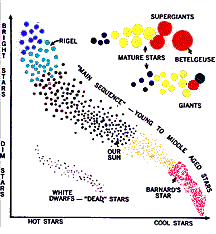
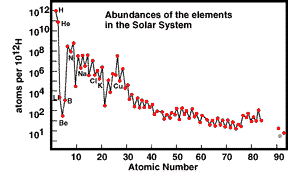
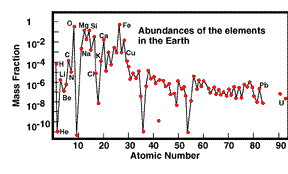
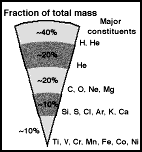
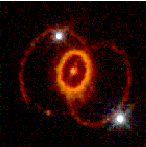 A recently
observed supernova was seen in the neighboring Large Magellenic Cloud
galaxy (a diffuse "satellite" galaxy of the Milky Way) early in 1987. Perhaps
the most famous supernova was seen by Chinese astronomers in July 1054
and was visible for several weeks in broad daylight. The visible remnant
of this huge explosion is now called the Crab
Nebula; see
A recently
observed supernova was seen in the neighboring Large Magellenic Cloud
galaxy (a diffuse "satellite" galaxy of the Milky Way) early in 1987. Perhaps
the most famous supernova was seen by Chinese astronomers in July 1054
and was visible for several weeks in broad daylight. The visible remnant
of this huge explosion is now called the Crab
Nebula; see